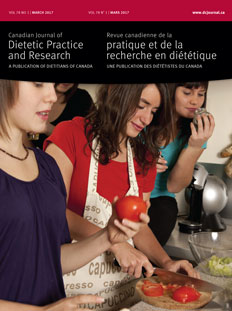Abstract
Purpose: Patients with diabetes (DM) and chronic kidney disease (CKD) are at increased risk for suboptimal bone health. The study objective was to investigate the relationships between vitamin D (vitD), vitamin K1 (vitK1), and calcium intake with bone mineral density (BMD) and vitamin D status in an ambulatory population with DM and CKD.
Methods: Adults (age 18–80 years; n = 62) with DM and CKD (stages 1–4) were recruited from the Northern Alberta Renal Program. Primary outcome variables included vitD, vitK1, and calcium intake; serum 25(OH)D, 1,25(OH)2D; and BMD as measured by dual X-ray absorptiometry. Statistical significance was determined at P < 0.05.
Results: Participants met the estimated average requirement or adequate intake for vitD, vitK1, and calcium intake in 73% (n = 45), 66% (n = 39), and 52% (n = 31), respectively, with a combined intake of micronutrient supplementation and diet. Participants had serum 25(OH)D concentrations ≥75 nmol/L (n = 41), normal BMDs (n = 48), and 66% (n = 41/62) were taking vitD supplements (>1000 IU/D). BMD was positively influenced by serum 25(OH)D. However, serum 25(OH) ≥100 nmol/L was associated with lower BMD (absolute and T-scores) for whole-body and spine (P ≤ 0.05). VitK1 intake (≥200 μg/day) was associated with higher whole-body and femoral–neck BMDs (absoluteand T-scores; P ≤ 0.05).
Conclusion: VitD status and BMD in adults with DM and CKD was influenced by vitD supplementation and vitK1 intake.
Résumé
Objectif : Les patients atteints de diabète et de maladie du rein chronique (MRC) présentent un risque accru d’avoir une santé osseuse sous-optimale. L’étude visait à étudier la relation entre l’apport en vitamine D, en vitamine K1 et en calcium et la densité minérale osseuse (DMO) et le statut en vitamine D chez une population ambulatoire atteinte de diabète et de MRC.
Méthodes : Des adultes (âgés de 18 à 80 ans; n = 62) atteints de diabète et de MRC (stades 1 à 4) ont été recrutés du Northern Alberta Renal Program. Les variables dépendantes principales incluaient l’apport en vitamine D, en vitamine K1 et en calcium; les taux sériques de 25(OH)D et de 1,25(OH)2D; et la DMO mesurée à l’aide de l’absorptiométrie à rayon X en double énergie. La signification statistique a été déterminée à P < 0,05.
Résultats : Les participants ont atteint le besoin moyen estimatif ou l’apport suffisant en vitamine D, en vitamine K1 et en calcium à raison de 73 % (n = 45), de 66 % (n = 39) et de 52 % (n = 31), respectivement, avec un apport combiné comprenant la supplémentation en oligo-éléments et l’alimentation. Les participants ont obtenu des taux sériques de 25(OH)D de ≥ 75 nmol/l (n = 41), des DMO normales (n = 48), et 66 % des participants (n = 41/62) prenaient des suppléments de vitamine D (> 1000 IU/jour). La DMO a été influencée de manière positive par le taux sérique de 25(OH)D. Cependant, les taux sériques de 25(OH) ≥ 100 nmol/l étaient associés à une DMO plus faible (absolue et scores T) pour le corps entier et la colonne vertébrale (P ≤ 0,05). L'apport en vitamine K1 (≥ 200 μg/jour) a été associé à des DMO plus élevées pour le corps entier et pour le col fémoral (absolue et scores T; P ≤ 0,05).
Conclusion : Le statut en vitamine D et la DMO chez les adultes atteints de diabète et de MRC étaient influencés par la supplémentation en vitamine D et l’apport en vitamine K1.



